
- •1. Electrostatic field. Coulomb’s law. Gauss law (Электростатическое поле. Закон Кулона. Закон Гаусса)
- •Variables and units
- •Coulomb’s Law. (ЗаконКулона)
- •Electric Field Strength e and Displacement Field d. (Напряжённостьисмещениеэлектрическогополя)
- •Gauss’ Law. (ЗаконГаусса)
- •2. Poisson’s and Laplace’s equations for the potential of electric field (Уравнения Пуассона и Лапласа для потенциала электрического поля) Electric Potential. (Электрический потенциал)
- •Poisson’s and Laplace’ s equations. (Уравнения Пуассона и Лапласа)
- •3. Electrostatic Energy (Электростатическая энергия) Electrostatic Energy (Электростатическаяэнергия)
- •Virtual experiment. (Эксперимент по нахождению энергии системы)
- •Consequences (Следствия)
- •4. Power and Joule’s Law (Энергия и закон Джоуля-Ленца)
- •5. Continuity Equation (Уравнения непрерывности) ContinuityEquation (Уравнение непрерывности)
- •Image method for the flat boundary between magnetic media (Метод изображений для плоской границы между магнитными носителями)
- •8. Static magnetic field. Biot–Savart’s Law. Ampere’s Law (Статическое магнитное поле. Закон Био–Савара. Закон Ампера)
- •Variables and units (Переменные и единицы измерения)
- •Main Relations (Основные соотношения)
- •Magnetic flux density (Индукция магнитного поля)
- •Biot-Savart’s law (Закон Био-Савара)
- •Ampere’s law (Закон полного тока)
- •The cut in the space (Разрез в пространстве)
- •Laplace equation for the scalar magnetic potential (Уравнение Лапласа для скалярного магнитного потенциала)
- •10. Vector magnetic potential. Inductance (Векторный магнитный потенциал. Индуктивность)
- •Vector magnetic potential (Векторный магнитный потенциал)
- •Magnetic flux (Магнитный поток)
- •Differential equation for the vector magnetic potential (Дифференциальное уравнение для векторного магнитного потенциала)
- •Gauging of the vector magnetic potential (Калибровка векторного магнитного потенциала)
- •Integral presentation of the vector magnetic potential (Интегральное представление векторного потенциала)
- •Inductance (Индуктивность)
- •Mutual inductance (Взаимная индуктивность)
- •Inductance of thin contours (Индуктивность тонких контуров)
- •12. Internal inductance of a thin conductor (Внутренняя индуктивность тонкого проводника) Flux linkage of a thin current layer (Потокосцепление тонкого слоя с током)
- •Internal inductance of a thin conductor (Внутренняя индуктивность тонкого проводника)
- •13. Inductance of a two wire transmission line (Индуктивность двухпроводной линии).
- •14. Variable separation method in a cylindrical coordinate system (Метод разделения переменных в цилиндрической системе координат). Application of Laplace’s equation (Применение уравнения Лапласа).
- •Angular function (Угловая функция)
- •Radial function (Радиальная функция)
- •General solution of the Laplace’s equation in a cylindrical coordinate system (Общее решение уравнения Лапласа в цилиндрической системе координат)
- •15. The Faraday’s law (Закон электромагнитной индукции).
- •Lenz’s Law (правило Ленца)
- •Induction by a temporal change of b (Индукция за счёт временного изменения b)
- •16. Induction through the motion of a conductor (Индукция за счет движения проводника).
- •17. Induction by simultaneous temporal change of b and motion of the conductor (Индукция одновременным изменением b во времени и движением проводника).
- •18. Unipolar generator (Униполярный генератор).
- •19. Hering’s paradox (Парадокс Геринга)
- •20. Diffusion of magnetic fields into conductors (Распространение электромагнитного поля в проводнике)
- •21. Periodic electromagnetic fields in conductors. (Периодическое электромагнитное поле в проводниках)
- •Penetration of the electromagnetic field into a conductor. (Проникновение электромагнитного поля в проводник)
- •The skin effect. (Скин-эффект)
- •22. Poynting theorem. (Теорема Пойнтинга) Electromagnetic Field Energy. (Энергия электромагнитного поля)
- •The rate of decrease of the electromagnetic field energy in a closed volume. (Скорость уменьшения энергии электромагнитного поля в замкнутом объёме)
- •Transmission of energy in a dc line (Передача энергии в линиях постоянного тока)
- •The field picture near the wires with current (Картина поля вблизи провода с током)
- •25. Energy flows in static electric and magnetic fields (Поток энергии в статических электрических и магнитных полях).
- •26. The reduced magnetic potential (Редуцированный магнитный потенциал). Reduced scalar magnetic potential (Редуцированный скалярный магнитный потенциал)
- •Combination of scalar magnetic potential and reduced magnetic potential (Комбинация скалярного магнитного потенциала и редуцированного магнитного потенциала)
- •27. Classification of numerical methods of the electromagnetic field modeling (Классификация численных методов моделирования электромагнитного поля).
- •Classification of the problems (Классификация проблем)
- •Classification of the methods (Классификация методов)
- •28. Method of moments
- •Discretization of the problem domain (Дискретизация проблемной области)
- •29. Basic principles of the finite element method.
- •30. Finite functions (Ограниченная функция – отлична от нуля только в пределах треугольника)
- •Simplex coordinates
- •Approximation of functions inside triangles (Аппроксимация функций внутри треугольника)
- •Approximation of the equation (Аппроксимация уравнения)
- •31. Weighted residual method (метод взвешенных невязок)
- •32. Weak formulation of the electromagnetic field modeling problem
- •33. Boundary conditions in electric and magnetic fields
- •1) First type boundary conditions
- •34. Main equations of electromagnetic field in integral form.
- •35. Main equations of electromagnetic field in differential form.
- •36. Electric field of a point charge (Электрическое поле точечного заряда)
- •37. Electric field of a uniformly charged sphere (Электрическое поле равномерно заряженной сферы)
- •38. Flat capacitor. Field. Surface charge. Capacity. (Плоский конденсатор. Поле. Поверхностный заряд. Вместимость.)
- •39.2 Inductance of a cylindrical coil with the rectangular cross section(Индуктивность цилиндрической катушки прямоугольного сечения).
- •4 0.1 Electric field induced by charged line placed above conducting surface (Электрическое поле, создаваемое заряженной линией, помещенной над проводящей поверхностью).
- •4 0.2. Magnetic field induced by the line with a current placed above a ferromagnetic surface with infinitely high magnetic permeability
The skin effect. (Скин-эффект)
The maximum value of the amplitude of the electromagnetic field corresponds to the left and right side of the conducting plate. When we move into the center of the conducting plate, the magnetic field decreases, and the amplitude become smaller and smaller. In the center the disappearing is almost completes.
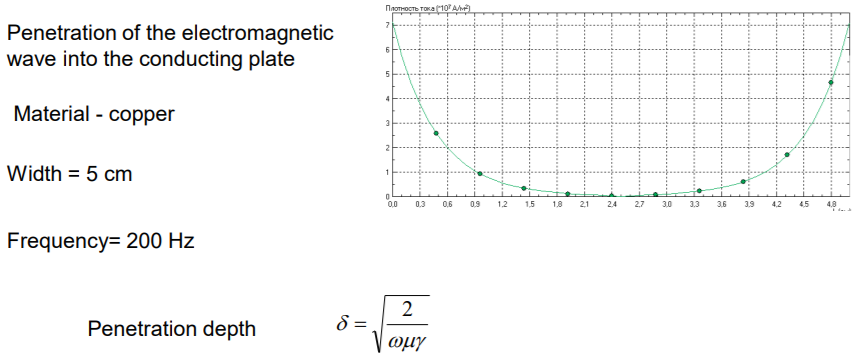
Penetration depth:
Penetration length – it’s the position where the amplitude decreases by the e = 2.73
22. Poynting theorem. (Теорема Пойнтинга) Electromagnetic Field Energy. (Энергия электромагнитного поля)
The energy of the electromagnetic field enclosed inside a certain volume V, bounded by a closed surface S, is determined by the volume energy density of the electric and magnetic fields.
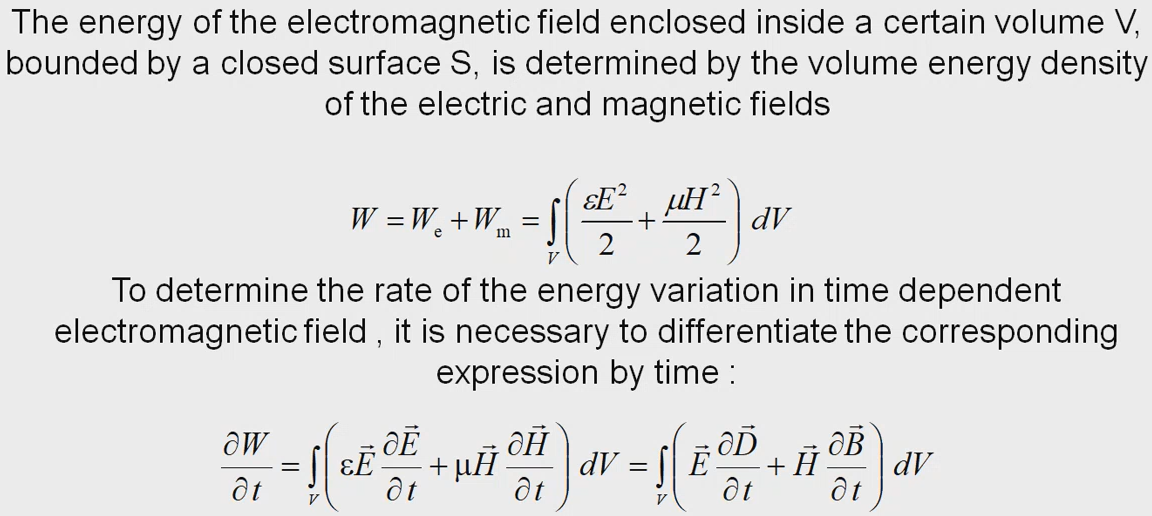
To determine the rate of the energy variation in time dependent electromagnetic field, it is necessary to differentiate the corresponding expression by time:
The rate of decrease of the electromagnetic field energy in a closed volume. (Скорость уменьшения энергии электромагнитного поля в замкнутом объёме)
The main relations between the characteristics of the electromagnetic field:
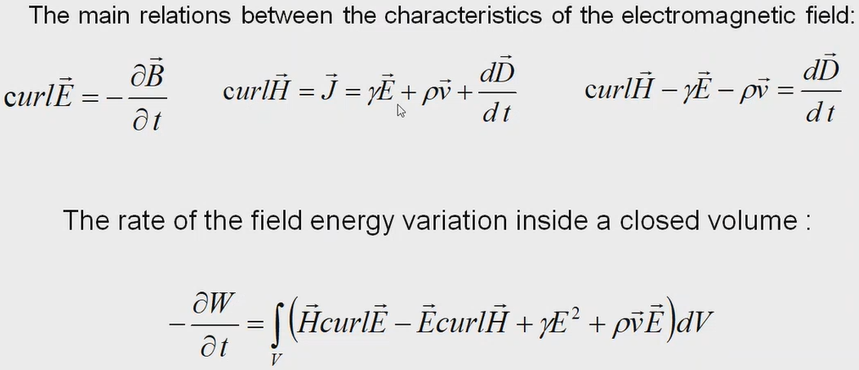
The rate of the field energy variation inside a closed volume:
T![]() he
volume of divergence of any vector may be replaced by the integral of
the closed surface of this volume.
he
volume of divergence of any vector may be replaced by the integral of
the closed surface of this volume.
Using the algebra formula , we get:
After applying the Gauss theorem:
The resulting expression is called the Poynting’s theorem:
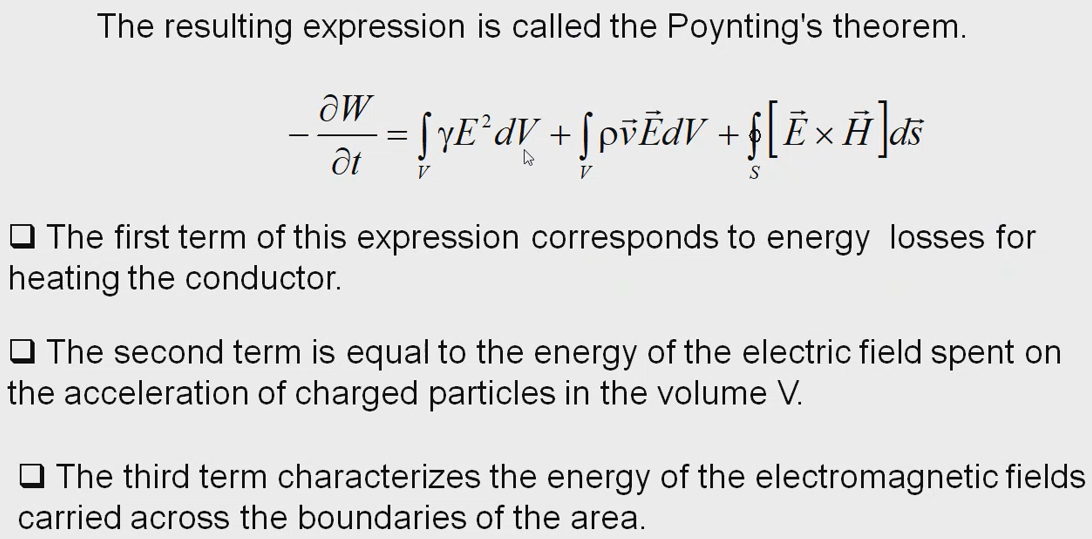
The first term of this expression corresponds to energy losses for heating the conductor.
The second term is equal to the energy of the electric field spent on the acceleration of charged particles in the volume V.
The third term characterizes the energy of the electromagnetic fields carries across the boundaries of the area.
The power of radiated electromagnetic energy is numerically equal to the flow of energy through the surface per unit of time.
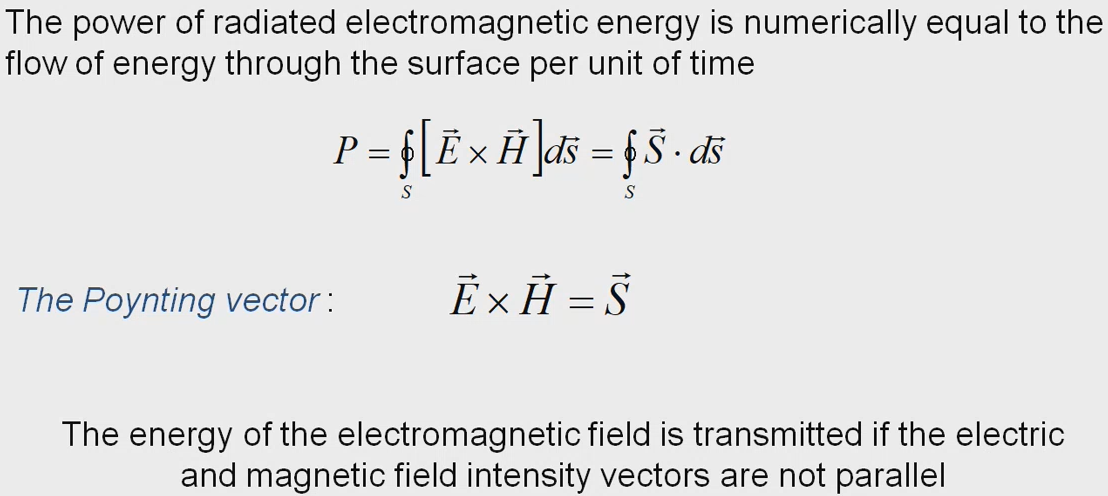
The Poynting vector:
The energy of the electromagnetic field is transmitted if the electric and magnetic intensity vectors are nor parallel.
23. Transmission of energy in 2-wire line loaded on a resistor (передача энергии по 2-проводной линии, нагруженной резистором)
Energy flows in the electromagnetic field
(Поток энергии в электромагнитном поле)
The energy flows take place in the time dependent electromagnetic fields. We just have seen that Poynting’s theorem claims. If the electromagnetic field depends on time it may cross the surface and so the total energy that was concentrated inside the volume may decrease or may increase as well. But also, we shall see that in static field nevertheless energy flow exists. The energy transmitted along the wires of the line is propagated in the dielectric, as well as the energy emitted by the antenna. Wires and cables only serve as guide for this energy.
Now, let’s consider two wire transmission lines which is loaded and the load is a resistor.

We should consider an electromagnetic field which is induced by all these wires. ∂W over ∂t (∂W/∂t). By the way in this case, in principle does not matter the time dependence of this current, it may be static current which does not depend on time but may be current that changes in time. According to the Poynting’s theorem ∂W/∂t may be expressed in this form.
What is V and S? We shall surround the space with the resistor in the load by the surface S and everything which is inside will be volume V. So, what we shall have inside the volume? The first term corresponds to the power losses inside the conducting material and that will be the resistor. Also, we should take in account that energy of the electromagnetic field may cross the surface which is described by this area S and this first term with V. We can find or we can express this integral from the Poynting vector as the sum of these two components:
So, we can conclude that increase in the electromagnetic field energy stored inside the volume and release of the thermal energy in the line wires and the load can occur only due to the influx of electromagnetic energy which enters this volume, which crosses this area S. If the current is static then the field distribution inside that volume will be constant. So ∂W/∂t will be equal to zero as well. In this case all energy which is dissipated (рассеянный) in this resistor will cross this surface and may be calculated as a vector product of E and H. The dissipated energy of this element can be very small, let’s neglect the energy, which is dissipated inside the wires, but the energy comes not through the wires, but through the space which surrounds these wires, lines here is only "subguides" (вспомогательные направляющие), guides along which the energy of the electromagnetic fields propagates (распространяется) and change their position.
